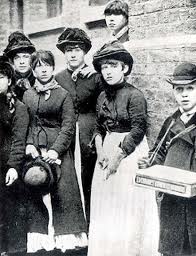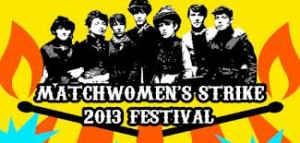Striking a Light: The Bryant and May Matchwomen and their place in Labour History, Louise Raw Continuum Press ISBN 978-1-4411-1426-6 Buy it from
Louise Raw’s book is not only a fascinating history of the strike of 1400 women and girls at the Bryant and May factory in 1888, but also an expose of how little real research has been done into what was in fact a key episode in British trade union history. Louise argues that it has been underplayed both in terms of their actions and the significance of the strike.
I hope this book will go some way towards restoring to these women and their workmates their own voice and agency,serving both as a rewriting of the very beginnings of modern British labour history and as a tribute to the women..
Louise starts off with the best of credentials for writing this political history as she has worked In the East End with local people and has herself been on strike with them. Her research on the Matchwomen provides us with a new story about the women who have been ignored by more famous and lauded historians. Her book is the first proper history of this group of women workers taking industrial action.
She had to write a history in the absence of any autobiographies written by the individual women, and with all the participants long dead. Her account of how she did this is fascinating. She spent several years laboriously tracing the women through local papers and history talks and eventually succeeded in interviewing and speaking to the grandchildren of those whom she now believed were the true leaders of the strike.
The rich and valuable testimony of these three matchwomen’s grandchildren allows us to see the women growing up and becoming mothers,wives and grandmothers.Far from being downtrodden, all were figures of some standing in their communities, and well respected despite not conforming to popular notions of female “respectability”.
One of the key myths of the strike is that Annie Besant (a middle class journalist and Fabian) actually led the strike. Louise demonstrates that in reality Besant was fundamentally opposed to the kind of action that the women instigated, in fact she wanted a more middle class compromise ie a boycott of the Bryant and May products.
This is an important book on many levels but particularly in giving back to these women and their descendants the true history of their lives. Too often in histories the independent actions and motivations of working class people are ignored or underplayed. This book conveys to us an understanding of who these women were and why they decided to go on strike. It also puts into context the vibrant political community they came from, largely Irish, a community that has through the years played a significant role in British trade union history. As Louise says:
Certainly there is good evidence that the working-class Irish community in the Victorian East End was a politicized one. The London Irish brought with them traditions of passive mass defiance, street violence and armed rebellion.
In this book Louise shows that the Matchwomen’s strike was an important element in the lead up to the wave of strikes, including the Great Dock Strike of 1889, which led to the birth of the trade union movement in this country and the creation eventually of the Independent Labour Party.
In 2013 as we are going through a major attack on public services in this country it is important that we look back and learn from past experiences. The Matchwomen are part of the fabric of the trade union movement in this country and as such quite rightly deserve their place in our history.
And what is the message from this book for women in 2013? Louise comments:
125 years on, women are suffering disproportionately under the Government’s austerity programme. The poor are once again divided into ‘deserving’ and ‘undeserving’ by both politicians and sections of the media. Migrant workers are demonised, and Michael Gove wants to drag school history back to the Victorian classroom.
If the truth about the matchwomen’s victory had always been acknowledged, and taught in schools rather than ‘buried’ by history, they could have offered powerful role models to generations of young children. The self-esteem of girls given positive historical and cultural role models has been shown to be measurably higher.
I believe we need to reclaim our history, and the fearless spirit of workers like these, as we face the challenges of today.
Louise has organised a festival to celebrate the Matchwomen see
If you have enjoyed this article and would like to support this blog by making a donation you can do using this button




This is great, thank you so much! x